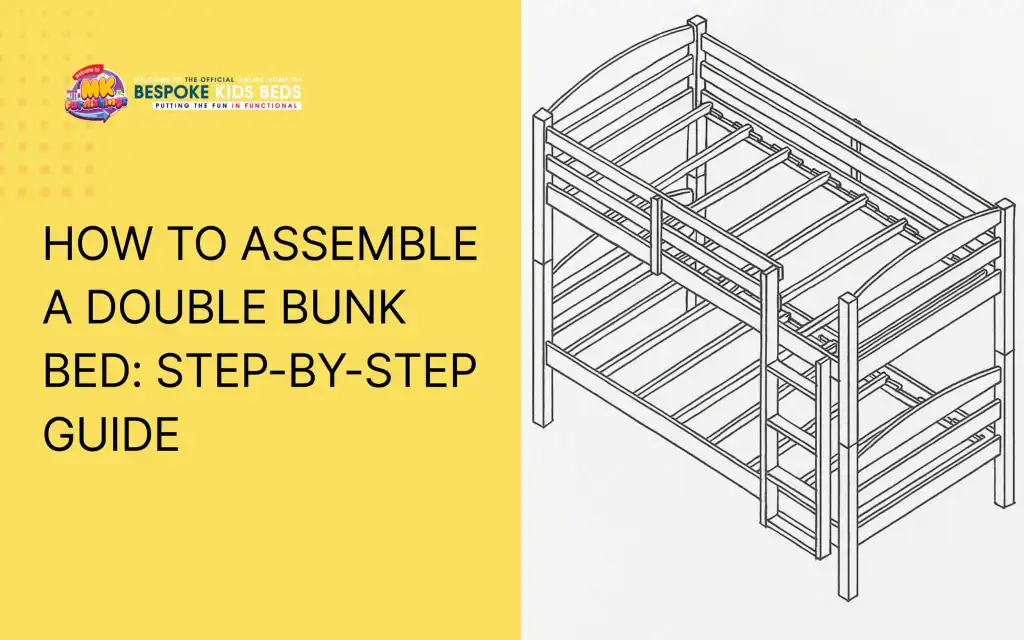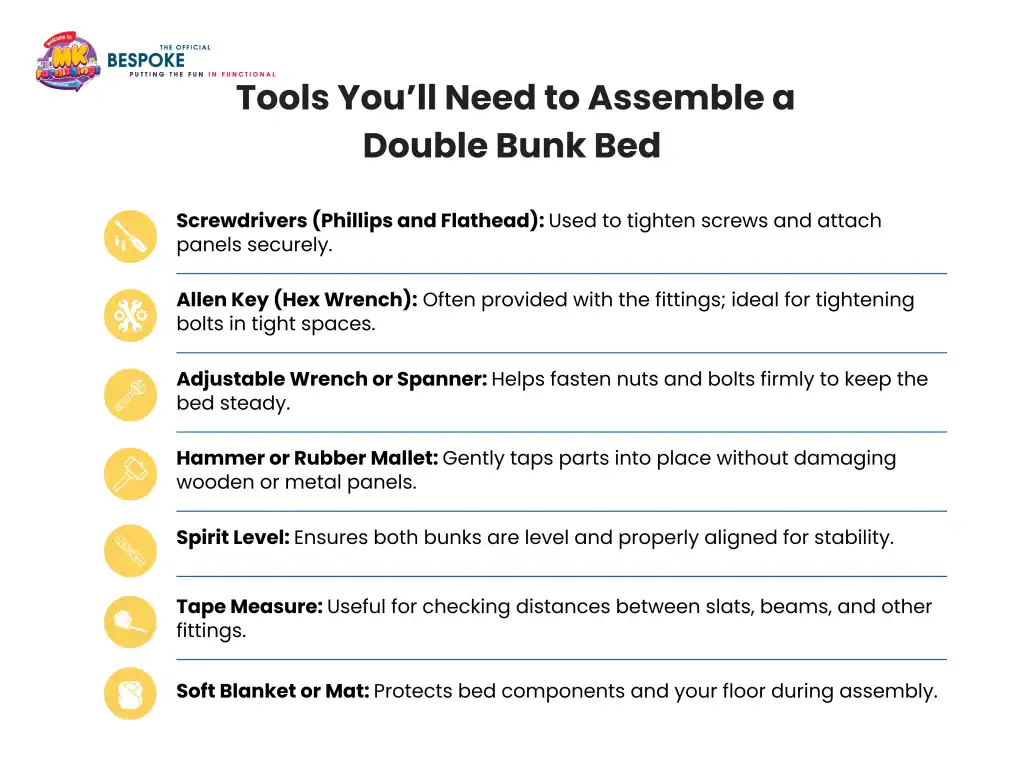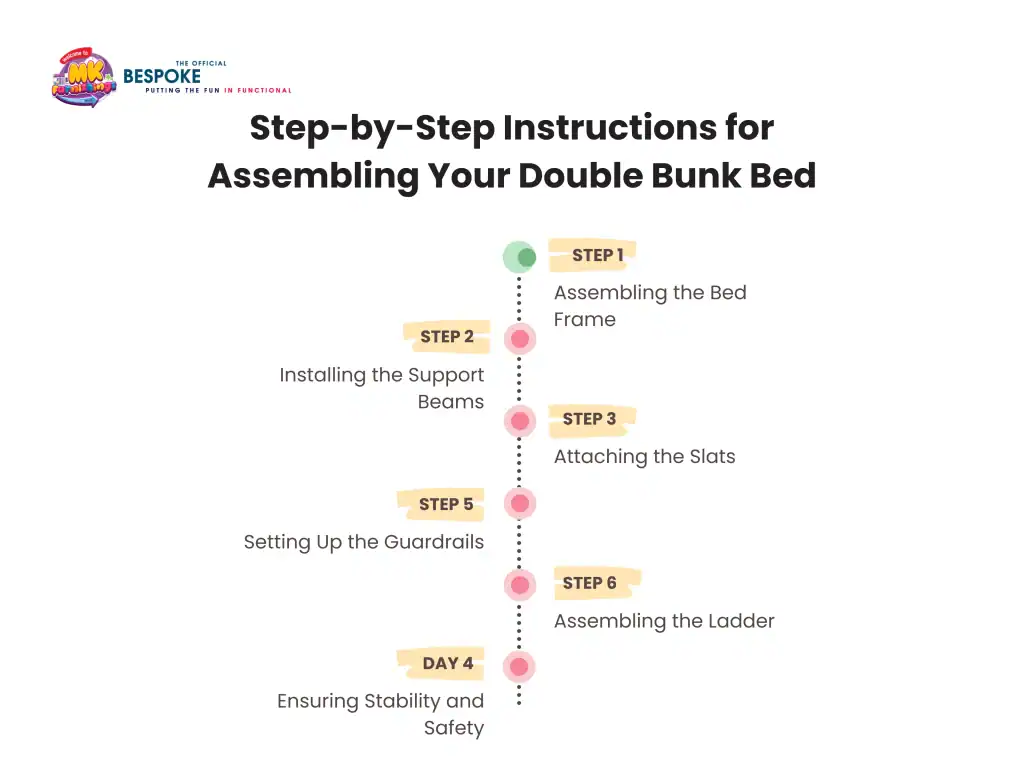
How to Dismantle a Bunk Bed?
A bunk bed is dismantled by taking out the bedding and mattresses, removing guardrails, detaching the ladder, separating the top bunk, and unfastening the frame.
Enjoy FREE Delivery on All Orders!

To assemble a double bunk bed, begin by organising all the parts, including the frame, support beams, slats, guardrails, and ladder. Place them on a flat surface and make sure every fixing, screw, and bolt from the instruction manual is accounted for. Start with the lower frame, then secure the upper bunk structure, tightening each section only after confirming that the alignment is accurate. This helps prevent wobbling and ensures both bunks remain sturdy once assembled.
Assembling a double bunk bed requires patience and attention to detail. Keep essential tools like screwdrivers, a wrench, and an Allen key within reach. Carefully attach the guardrails to the top bunk to maintain safety and stability, and double-check each fixing before fitting the mattresses. This guide will help you build a safe, durable, and comfortable double bunk bed that fits perfectly into your child’s room while offering peace of mind once it is ready for use.
A double bunk bed is built from several key parts, including the bed frame, support beams, slats, guardrails, and ladder that work together to create a stable and safe sleeping structure. The bed frame forms the main foundation, holding both bunks securely in place. Support beams strengthen the structure and prevent sagging, while slats support the mattresses and promote airflow. Guardrails on the top bunk ensure safety by preventing falls, and the ladder allows easy and secure access to the upper bunk.
Knowing how these parts function in detail helps you assemble the double bunk bed correctly and safely.
The bed frame forms the core structure of a double bunk bed, connecting the headboard, footboard, and side panels to support both bunks securely. Whether made from wood or metal, a sturdy frame prevents wobbling, squeaking, and long-term wear.
To assemble it correctly, place all panels on a level surface and check that the corners align perfectly. Tighten each bolt in sequence to maintain even pressure and prevent twisting. Once the frame stands upright, recheck for balance from every angle. A stable frame provides the strength needed to support the upper bunk safely, giving parents confidence that their child’s bed is solid, durable, and built to last.
Support beams are the stabilising elements that strengthen the double bunk bed by reinforcing its frame and distributing weight evenly across both bunks. Positioned beneath the sleeping areas, they prevent sagging and add strength to the overall frame. When installed correctly, these beams ensure that each bunk maintains its shape and can safely hold the mattress and sleeper.
During assembly, insert each beam firmly into its bracket, ensuring it lies flat and level before tightening. Avoid leaving any gaps that could weaken the structure. Once installed, apply gentle pressure to check for stability. Properly fitted beams keep both bunks secure and reduce strain on other parts, helping the bed maintain its shape and strength over time.
In a double bunk bed, slats serve as the primary base that supports the mattress and keeps it properly balanced. They distribute weight evenly across the frame, preventing the mattress from sagging and allowing air to circulate for better comfort and hygiene. Align the slats evenly across the support beams or slots as outlined in the instructions
To fit the slats in a double bunk bed, follow the layout provided in the instructions and align each one evenly along the support beams. Secure them with equal pressure on both ends, avoiding over-tightening that could cause bending. When done, press gently in the middle to confirm that no slat lifts or shifts. Correct installation provides balanced support for the mattress, reduces sagging, and keeps the entire double bunk bed sturdy.
On a double bunk bed, guardrails (safety rails) act as sturdy side barriers that protect the sleeper without restricting comfort or movement. Under the British Safety Standard BS EN 747-2012+A1, guardrails must be installed on both sides of the upper bunk, with a minimum height of 16 cm above the mattress surface. The gaps between the guardrail and the bed frame should not exceed 7.5 cm to avoid any risk of entrapment.
During assembly, position them along the mounting points and fasten securely using the provided fittings. After installation, press gently along the rails to test firmness. Correctly installed guardrails ensure the double bunk bed for kids and adults meets UK safety standards and remains stable for daily use.
The ladder is an essential component of a double bunk bed, giving children safe and easy access to the top bunk. It must be securely fixed to the bed frame to prevent movement or tipping during use. According to UK safety standards for double bunk beds, the ladder’s rungs should be evenly spaced, with gaps no greater than 30 cm, and firmly attached to the frame or floor for added stability.
When assembling, align the ladder with the specified mounting points and tighten all bolts or screws properly to ensure a secure fit. Once installed, test each rung by applying gentle pressure to confirm it can hold weight without shifting. A properly assembled ladder guarantees safety, convenience, and long-term durability for the double bunk bed.

Before starting the assembly of a double bunk bed, you will need a few essential tools such as screwdrivers, an Allen key, a wrench, a hammer or rubber mallet, a spirit level, and a tape measure. Keeping these tools close at hand before beginning ensures a smooth assembly on delivery day and helps you build a sturdy, safe, and long-lasting double bunk bed.
Essential tools to assemble a double bunk bed and their purpose:

To assemble a double bunk bed, begin by setting up the bed frame, then install the support beams and slats to create a strong base for the mattresses. Next, secure the guardrails on the upper bunk to ensure safety, followed by attaching the ladder for easy access. Finish by checking the overall stability and alignment before use. Each step builds towards a sturdy and safe double bunk bed setup suitable for everyday use.
Lay out the main frame parts of the double bunk bed on a flat surface. Connect the headboard, footboard, and side panels using the screws or bolts provided. Align each joint carefully to ensure both bunks are level and balanced. Once secured, check that the structure stands upright without wobbling, as this frame supports the weight of both sleeping areas.
Position the support beams along the inside of the double bunk bed frame as shown in the instructions. Fit each beam tightly into its bracket and secure it with screws or bolts. These beams carry the mattress weight and stop the bed from sagging. Make sure they sit evenly and are fully tightened to maintain long-term stability for both bunks.
Lay the slats across the support beams or bed base, spacing them evenly to ensure proper mattress support and airflow. Secure each slat firmly in its slot using the fittings provided. Once done, press lightly at the centre of each slat to confirm it is locked in place. Well-fitted slats keep both mattresses level and comfortable for children’s safe sleep.
Attach the guardrails along both sides of the upper bunk. Use the supplied fittings to secure them tightly, ensuring they do not move under pressure. Guardrails are vital for preventing falls and must meet UK safety standards, with a minimum height of 16 cm above the mattress surface. Double-check that each rail is firmly fixed before continuing to the next step.
Position the ladder at the designated point of the double bunk bed, either at the end or side, depending on the model. Fix it securely to the frame using screws or bolts. The ladder’s rungs should be evenly spaced, no more than 30 cm apart, to allow safe climbing. Once fitted, test for stability to ensure children can use it confidently.
After completing assembly, inspect the entire double bunk bed carefully. Tighten any loose screws and confirm that the ladder, guardrails, and frame are firmly attached. Shake the structure gently to ensure it does not sway or creak. This final step guarantees that the double bunk bed is stable, secure, and ready for safe daily use.
When assembling a double bunk bed, following proper safety precautions and tips, such as checking stability, installing guardrails securely, and placing the correct mattress size, is essential to create a secure and long-lasting setup. Each of these factors plays a key role in protecting children from potential hazards and ensuring safe daily use of double bunk beds.
Before children use the double bunk bed, test its stability to make sure the structure is firm. Apply light pressure to the frame, ladder, and corners to detect any wobble or movement. If there is any creaking or shifting, tighten the bolts again and recheck alignment. Make sure the double bunk bed stands level on the floor with no uneven legs or surfaces underneath. A stable bunk bed not only prevents accidents but also prolongs its lifespan. Regularly inspecting and tightening the fixings will help maintain safety, giving you confidence that the double bunk bed is strong and secure over time.
Proper guardrail installation is essential for protecting children sleeping on the top bunk. Fit the guardrails securely on both sides of the bunk bed using the provided brackets and screws, ensuring they extend at least 16 cm above the mattress surface. Avoid gaps larger than 7.5 cm between the guardrail and the frame to meet UK safety standards. Once installed, press gently along the rail to ensure it does not move. Guardrails act as a crucial safety barrier, reducing the risk of falls during sleep. Double-check that each fixing is tight before allowing use, ensuring the top bunk provides both comfort and peace of mind for parents.
Correct mattress placement ensures both safety and comfort in a double bunk bed. Always use the mattress size recommended by the manufacturer to ensure a snug fit within the frame. A mattress that is too thick can reduce the height of the guardrails, increasing the risk of falling, while one that is too small may leave dangerous gaps. Place the mattress evenly on top of the slats or solid base and make sure it sits flush against all sides. Once positioned, press down to check for even support and no shifting. A properly fitted double bed mattress keeps the sleeping surface secure, ensuring a safe and restful environment for children every night.
Common mistakes to avoid during bunk bed assembly include misaligned parts, skipping safety checks, or using an incorrect mattress size. Each of these issues can weaken the structure or increase the risk of accidents, especially when used by children. Avoiding these errors ensures your double bunk bed remains sturdy, secure, and ready for safe everyday use.
One of the most common issues during double bunk bed assembly is misalignment between parts. When joints, panels, or beams do not line up properly, it can cause gaps and uneven weight distribution, leading to an unstable frame. Misalignment may also result in creaking or movement when pressure is applied. To prevent this, assemble the bed on a flat surface and tighten bolts in stages rather than all at once. Use a spirit level to confirm accuracy before final tightening. Ensuring every connection fits precisely keeps the double bunk bed structure firm and balanced, preventing future loosening and maintaining a safe, sturdy structure.
Skipping safety checks is a mistake that can compromise the strength and security of a double bunk bed. Neglecting to inspect bolts, guardrails, and ladder fittings increases the risk of movement or collapse over time. After each major assembly step, test the bed’s stability by applying pressure on the frame and climbing the ladder. Make sure all screws and fittings are tight and that the guardrails are fixed firmly to prevent accidents. Completing a final inspection before using the double bunk bed is vital to confirm that every component is secure.
Using an incorrect double bed mattress size is another common mistake that affects both comfort and safety in a double bunk bed. A mattress that is too thick can reduce guardrail height, increasing the risk of falls, while one that is too small can leave dangerous gaps around the edges. Always use the mattress dimensions recommended by the manufacturer for each bunk. Ensure the mattress sits flush against the frame and rests evenly on the slats or base, maintaining the double bunk bed’s safety standards. It is also worth noting that bunk bed mattresses are different from standard mattresses; they are usually thinner and designed to fit safely within the guardrail height limits.
When choosing the right double bunk bed, consider design features such as stairs or ladders, built-in storage, and the type of material used. Each element impacts not only how the double bunk bed looks but also how practical and safe it is for children. Here are some of the different double bunk bed types you can choose from:
When comparing bunk beds with stairs versus those with ladders, safety and space are the main considerations. Stairs provide easier and more stable access for younger children, often featuring built-in drawers or shelves for extra storage. However, they require more floor space.
Bunk beds with ladders, on the other hand, are compact and ideal for tighter rooms but may require greater caution when climbing. Fixed ladders offer better stability than removable ones. For families with smaller children, a stair design provides added safety and functionality, while a ladder-style bunk bed suits older children or limited spaces. Choose a double bunk bed based on your room layout, available space, and how the bed will be used daily.
A bunk bed with drawers is an excellent solution for families looking to maximise storage in smaller bedrooms. The drawers, often built into the stairs or under the lower bunk, help keep clothes, toys, or bedding neatly organised without needing extra furniture. This design not only saves floor space but also makes tidying up easier for children.
When selecting a bunk bed with drawers model, look for smooth drawer runners and sturdy frames to ensure durability. Built-in storage adds convenience and reduces clutter, creating a more functional and spacious environment. For growing families, a bunk bed with drawers combines practicality and design, making it a smart long-term investment.
The choice between wood and metal bunk beds affects both style and performance. Wooden bunk beds offer warmth, classic aesthetics, and excellent durability, though they may be heavier and take longer to assemble. Metal bunk beds are lightweight, modern, and easier to move, but they can creak over time if not assembled tightly.
Wood is often preferred for younger children due to its sturdiness and smoother finish, while metal works well for older kids or teenagers. Consider the room’s decor, maintenance needs, and safety preferences when choosing materials. Selecting the right build ensures your double bunk bed remains durable, attractive, and comfortable for years of use.
Taking your time during the assembly of a double bunk bed helps prevent mistakes and ensures a safe and sturdy finish. Rushing through the process can cause loose fittings, uneven alignment, or missed safety checks, which may affect long-term stability.
Here are some tips for assembling your double bunk bed:
You will need a few basic tools such as a screwdriver, Allen key, wrench, hammer or rubber mallet, and a spirit level. Having these ready before starting makes assembly smoother and ensures every part fits securely.
On average, it takes around one to three hours to assemble a double bunk bed, depending on your experience and whether someone helps. Working methodically and following the manual reduces time and errors.
While it is possible to assemble a double bunk bed alone, it is safer and easier with two people. Having assistance helps align larger sections like the upper frame and ladder more accurately.
Yes, double bunk beds are safe when assembled correctly with guardrails, stable fixings, and the right mattress size. A double bunk bed following UK safety standards ensures long-term stability and protection for children.
The weight limit of a double bunk bed depends on its design and build quality, with standard models made for children generally holding between 175 and 250 pounds (80 to 115 kg) per bunk, while reinforced or adult versions can handle up to 400 pounds (181 kg) or more. Always refer to the manufacturer’s guidelines for the exact weight rating of your specific model to ensure safe use and long-term durability.
Kyle Kane
Owner
Kyle Kane is Co-Owner of MK Furnishings, a family-run business based in UK that specializes in high-quality custom kids’ bunk beds, including triple, double, single, and themed designs. Since launching the company in 2016 alongside his brother-in-law, Kyle has helped deliver and assemble thousands of beds across the UK, Ireland, and beyond. Focused on customer satisfaction, Kyle leads a hardworking team that handles every step from ordering to delivery ensuring a smooth and professional service. His commitment to quality craftsmanship and reliable support has earned MK Furnishings a strong reputation and growing customer base throughout the region.

A bunk bed is dismantled by taking out the bedding and mattresses, removing guardrails, detaching the ladder, separating the top bunk, and unfastening the frame.

To assemble a double bunk bed, begin by organising all the parts, including the frame, support beams, slats, guardrails, and ladder. Place them on a
Fancy £50 off all orders! Enter in 50off to redeem in the coupon code section